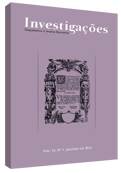A violência velada e revelada em três contos de Caio Fernando Abreu
Abstract
A literatura de Caio Fernando Abreu pode ser compreendida pelo viés da nova narrativa, termo designado por Antonio Candido (2000) para definir textos desvinculados dos critérios canônicos. Irreverente e reveladora, sua ficção narrativa expressa o mal-estar da cultura mediante questões consideradas marginais. Temas como homossexualismo, solidão e doenças são privilegiados em sua obra, revelando uma visão de mundo permeada de ideologias caracterizadoras da sociedade contemporânea. Nessa perspectiva, pretendemos analisar os contos: “Aqueles dois”, “Depois de Agosto” e “Sargento Garcia”, observando, na ação das personagens, como se configura a temática da violência – física ou psicológica.References
ABREU, C. F. 2002. Ovelhas Negras. São Paulo: L&PM Editores.
______. Morangos Mofados. 1996. São Paulo: Companhia das Letras.
CANDIDO, A. 2000. A educação pela noite e outros ensaios. São Paulo: Ática.
CHEVALIER, J. e GHEERBRANT, A. 1992. Dicionário de Símbolos: mitos, sonhos, costumes, gestos, formas, figuras, cores, números. 6° ed. Trad. V. da C. Silva. et al. Rio de Janeiro: José Olympio.
COSTA, J. F. 2003. Violência e psicanálise. 3° ed. Rio de Janeiro: Graal.
ODALIA, N. 1983. O que é violência. São Paulo: Brasiliense.
PELLEGRINI, T. 1999. História de um novo tempo: Caio Fernando Abreu. In.
______. A imagem e a letra: aspectos da ficção brasileira contemporânea. Campinas: FAPESP.
Downloads
Published
How to Cite
Issue
Section
License
Copyright (c) 2011 Maria Aparecida da Costa Gonçalves Ferreira, Antonia Marly Moura da Silva, José Vilian Mangueira

This work is licensed under a Creative Commons Attribution 4.0 International License.
Authors who publish with Revista Investigações agree to the following terms:
Authors retain copyright and grant the journal right of first publication with the work simultaneously licensed under the Creative Commons Attribution 4.0 International (CC BY 4.0) license that allows others to share the work with an acknowledgement of the work's authorship and initial publication in this journal.
Authors are able to enter into separate, additional contractual arrangements for the non-exclusive distribution of the journal's published version of the work (e.g., post it to an institutional repository or publish it in a book), with an acknowledgement of its initial publication in this journal.
You are free to:
Share — copy and redistribute the material in any medium or format for any purpose, even commercially.
Adapt — remix, transform, and build upon the material for any purpose, even commercially.
The licensor cannot revoke these freedoms as long as you follow the license terms.
Under the following terms:
Attribution — You must give appropriate credit , provide a link to the license, and indicate if changes were made . You may do so in any reasonable manner, but not in any way that suggests the licensor endorses you or your use.
No additional restrictions — You may not apply legal terms or technological measures that legally restrict others from doing anything the license permits.

